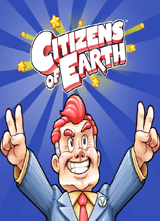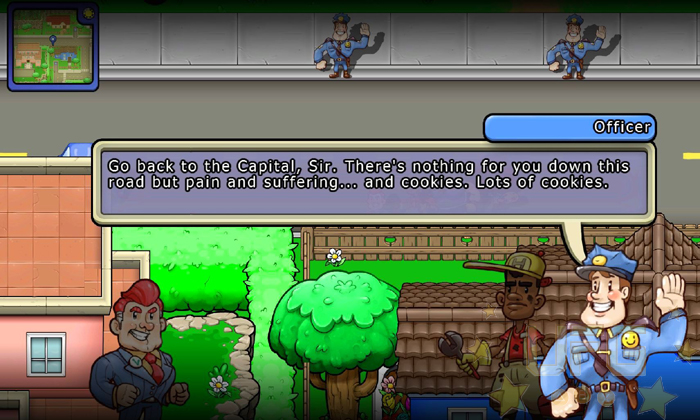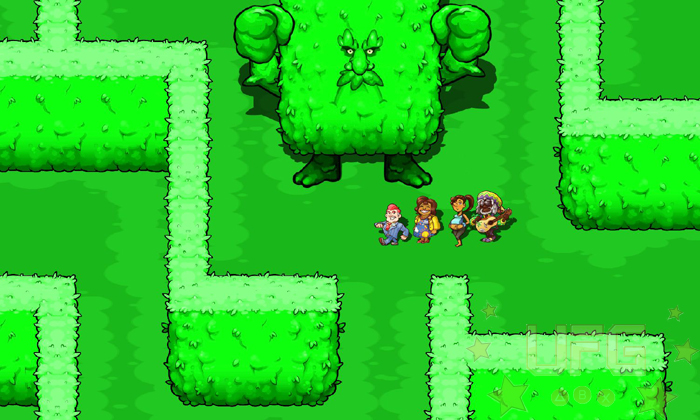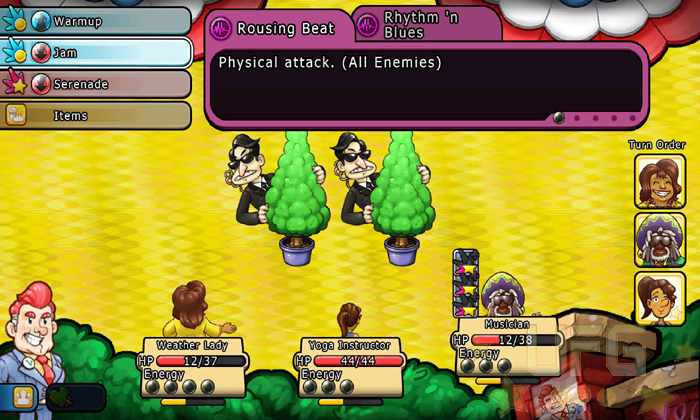Citizens of Earth
Nostalgia can be a powerful yet precarious element of game design. That’s not to say that it’s innately negative or anything; in moderation nostalgic game components can bring back fond memories, serve as a history lesson to new players, or revitalize a genre by being combined with newer gaming mechanics. The problem comes when a developer tries to recreate the magic of old by sticking strictly to the past. Some things just aren’t as great as we remember…
This brings me to Eden Industries latest RPG, Citizens of Earth. It follows the story of the newly elected Vice President of the World (yup, the world). A day after winning the election, strange things start happening around his home town. For some reason, the townsfolk have become super happy, seemingly because of a special blend of coffee being peddled by the Moonbucks coffee shop. After some investigating, the VP finds out that there is some sort of conspiracy going on – the people are being controlled, unable to go about their normal routines due to their addiction to the coffee. This journey to find out what’s going on with the citizens leads to a bizarre tale involving talking animals, happy-go-lucky aliens, and cyborgs posing as regular humans. It’s like the movie “They Live” but far goofier (not a bad thing mind you).
CoE was designed with old school RPGs in mind. As the story continues, you’ll travel all around the world completing quests and recruiting new civilians to your roster. They each have talents based on their occupation allowing for different types of attacks, buffs, etc. That said, only three of them can be out in the field at a time. The baddies will move about the open world in plain sight so you won’t have to worry about random enemy encounters. If you do get into a scuffle, which happens whenever you touch an enemy, the game will pull your 3-man party into a turn based fight. Once the battle concludes, you’ll be awarded experience points and an occasional item or piece of gear before being kicked back to the open world. Each chapter is bookended with a boss fight and story beats that point you in the direction of your next major quest.
While my breakdown of the game seems monotonous, it was rather entertaining at first. The odd premise with its political slant, old school mechanics, and the promise of over 40 different characters to recruit had me hooked for hours. It wasn’t until I was about halfway through the game that I realized I wasn’t having as much fun as I thought I would. This revelation came first by way of the frequent fighting. The best way to explain what I mean is to divulge how an average chapter played out.
A problem will present itself and it’ll be up to you to solve it. In order to get to the bottom of whatever’s going down, you’ll have to make your way through a maze like environment littered with enemies. Even though you can see them the narrow passageways make it incredibly hard to sneak by; some enemies completely block your path, lowering the chance of avoiding the fight to nil. If you make a wrong turn in the maze and walk into a new area or enter a building, you’ll have to backtrack. Unfortunately, all of the enemies you dispatched along the way will respawn when you reenter the maze. Once you make it to the source of the problem – a Moonbucks coffee shop, a corrupt factory, etc. – you’ll again have to work your way through a maze full of enemies before facing the boss. Lather. Rinse. Repeat.
Now I know that most turn based RPGs utilized frequent enemy encounters. The idea was to make sure that if you skipped the side quests you’d still be close to the required level needed to complete a major story thread. Well, one of the issues with CoE is that the grind isn’t needed. Even if you skip the side quests and forgo recruiting citizens, the constant fighting will keep you overpowered; I literally beat the final boss in less than a minute without any thought given to the well-being of my group. To be fair, there is a citizen that can alter the game’s difficulty making encounters much tougher. I shied away from that option though due to the other issues I had with the game – the story and the combat, neither of which were very compelling after reaching the halfway mark.
I would have forgiven all of the tedious fighting if I had been treated to a worthy narrative. Or anything that would make me care about the VP’s current crusade. Instead I got a lackluster plot that went nowhere fast, which is shocking considering all of the random elements found throughout. I mean, at one point you fight a giant bear made out of honey and super hippies; these are pretty creative characters, one would think they would be part of a more elaborate plot. And that’s where the narrative was pointed until a twist towards the end placed it squarely in the cliché.
The excessive fighting might have also been excused if the combat was more involved. There just isn’t much too it strategically speaking. All you need to know is that regular attacks build power for you to use stronger attacks, some enemies are vulnerable or resistant to certain elemental moves, and picking the wrong one might remove some power needed for later moves. That’s it. Sure, each citizen’s skills are based on their jobs, which could have been interesting given the large pool of characters, but they all tend to fall into the normal RPG archetypes. Some are really straightforward, like the baker who creates healing bread for his allies. Others seem different but only on paper – the VP’s mother can nag enemies, causing their defenses to drop for a few turns. Outside of it being funny to read that a foe was nagged to death, there isn’t anything that stands out. What’s worse is that there aren’t that many elemental attacks/buffs in the game, making it easy to just rely on three well rounded characters to complete the game. Why waste time leveling the other citizens?
It seems like Eden Industries simply wanted to make a classic turn-based RPG. And for the most part it isn’t that bad of a game. It just seemed to be infused with too many old mechanics without first establishing a proper balance. The simple combat is made boring when combined with so many unavoidable fights. The hours invested in grinding through to the end were cheapened by a weak story and uninspired main characters. And all of the peculiar creatures and set pieces seemed like wasted opportunities to strengthen the plot.
In Phantasy Star, we had a female lead avenging the death of her brother. In Final Fantasy we had an interesting world full of well-designed characters and fierce monsters. In both, though the combat was simple, there was a lot going on that forced you to pay attention. Outside of those things was this sense of something new; FF was the first game to show the heroes and the monsters instead of using a first person view. This trend of offering something new continued as each series’ evolved. Sure, it’s great to go back and replay the old entries but that’s only because of our fond memories of them (aside from their good stories). Bottom line, classic RPG’s are hard to emulate. Just featuring an older style of play and hours of grinding isn’t enough to bring back the magic of yesteryear. There has to be more…
Gameplay:
5
It’s really fun at first. After a while though, the fighting becomes a chore and the story becomes forgettable.
Graphics:
8
I like the old RPG aesthetics.
Sound:
6
There are a few good tracks that are worth a listen. The character’s in-fight catch phrases get old really fast.
Replay Value:
5
There is a game + mode offered once you complete the story. Whether or not you’d want to go through the game again is the question.
Final Score:
6




